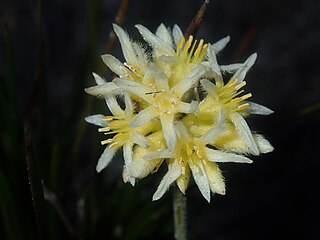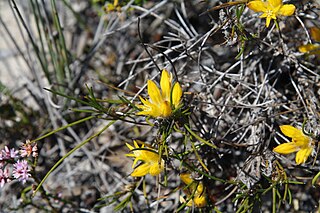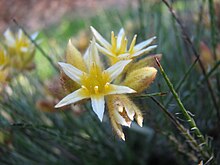
Conostylis pusilla is a rhizomatous, tufted perennial, grass-like plant or herb in the family Haemodoraceae, and is endemic to the south-west of Western Australia. It has flat leaves and hairy yellow flowers usually arranged in pairs on a flowering stem.

Conostylis caricina is a flowering plant in the family Haemodoraceae and is endemic to the south-west of Western Australia. It is a rhizomatous, tufted perennial, grass-like plant or herb with flat leaves and heads of 6 to 8 creamy-yellow flowers.

Conostylis crassinerva is a rhizomatous, tufted perennial, grass-like plant or herb in the family Haemodoraceae and is endemic to the south-west of Western Australia. It has flat leaves and yellow tubular flowers that turn reddish as they age.

Conostylis dielsii is a tufted perennial, grass-like plant or herb in the family Haemodoraceae and is endemic to the south-west of Western Australia. It forms short rhizomes, and has cylindrical leaves and creamy-yellow flowers.

Conostylis drummondii is a rhizomatous, tufted perennial, grass-like plant or herb in the family Haemodoraceae and is endemic to the south-west of Western Australia. It has short stems, and has more or less cylindrical leaves and pale lemon-yellow flowers.

Conostylis festucacea is a rhizomatous, tufted or proliferous perennial, grass-like plant or herb in the family Haemodoraceae, and is endemic to the south-west of Western Australia. It has cylindrical or flat leaves and yellow flowers.

Conostylis laxiflora is a rhizomatous, tufted perennial, grass-like plant or herb in the family Haemodoraceae and is endemic to the south-west of Western Australia. It has flat, glabrous leaves, and yellow, tubular flowers.
Conostylis lepidospermoides, commonly known as sedge conostylis, is a rhizomatous, tufted perennial, grass-like plant or herb in the family Haemodoraceae and is endemic to the south-west of Western Australia. It has flat, yellowish-green, glabrous leaves, and lemon-yellow, tubular flowers.

Conostylis misera, commonly known as grass conostylis, is a prostrate, rhizomatous, tufted perennial, grass-like plant or herb in the family Haemodoraceae, and is endemic to the south-west of Western Australia. It has flat leaves and bright yellow flowers usually arranged singly on a short flowering stem.
Conostylis pauciflora, commonly known as Dawesville conostylis, is a rhizomatous, stoloniferous, perennial, grass-like plant or herb in the family Haemodoraceae and is endemic to the south-west of Western Australia. It has flat, green leaves with bristles on the edges, and relatively few tubular flowers.
Conostylis petrophiloides is a rhizomatous, tufted perennial, grass-like plant or herb in the family Haemodoraceae and is endemic to the south-west of Western Australia. It has flat, glabrous leaves, and yellowish-cream coloured, tubular flowers.

Conostylis prolifera, commonly known as mat cottonheads, is a rhizomatous, tufted, stoloniferous, perennial, grass-like plant or herb in the family Haemodoraceae and is endemic to the south-west of Western Australia. It has flat, glabrous leaves, and yellow and cream-coloured, tubular flowers.
Conostylis rogeri is a rhizomatous, tufted perennial, grass-like plant or herb in the family Haemodoraceae and is endemic to a small area in the south-west of Western Australia. It has small tufts, flat leaves, and a single pale yellow, tubular flower.

Conostylis seminuda is a rhizomatous, tufted perennial, grass-like plant or herb in the family Haemodoraceae and is endemic to a small area in the south-west of Western Australia. It has flat leaves and golden yellow, tubular flowers.

Conostylis seorsiflora is a rhizomatous, tufted perennial, grass-like plant or herb in the family Haemodoraceae and is endemic to the south of Western Australia. It has flat leaves and yellow, tubular flowers.

Conostylis setosa, commonly known as white cottonhead, is a rhizomatous, tufted perennial, grass-like plant or herb in the family Haemodoraceae and is endemic to the south-west of Western Australia. It has flat leaves and white, or pinkish maroon to purple flowers

Conostylis teretifolia is a rhizomatous, tufted, perennial, grass-like plant or herb in the family Haemodoraceae and is endemic to the south-west of Western Australia. It has flat leaves, short stems and yellow to reddish, tube-shaped flowers.

Conostylis teretiuscula is a rhizomatous, tufted perennial, grass-like plant or herb in the family Haemodoraceae and is endemic to the south west of Western Australia. It has flat leaves and yellow, tube-shaped flowers.

Conostylis vaginata, commonly known as sheath conostylis, is a rhizomatous, tufted perennial, grass-like plant or herb in the family Haemodoraceae, and is endemic to the south of Western Australia. It has much-branched stems, grass-like leaves and yellow flowers arranged at the base of the leaves.
Conostylis villosa is a rhizomatous, tufted perennial, greyish-green, grass-like plant or herb in the family Haemodoraceae and is endemic to the south west of Western Australia. It has flat leaves and yellow flowers aging purplish-red.















